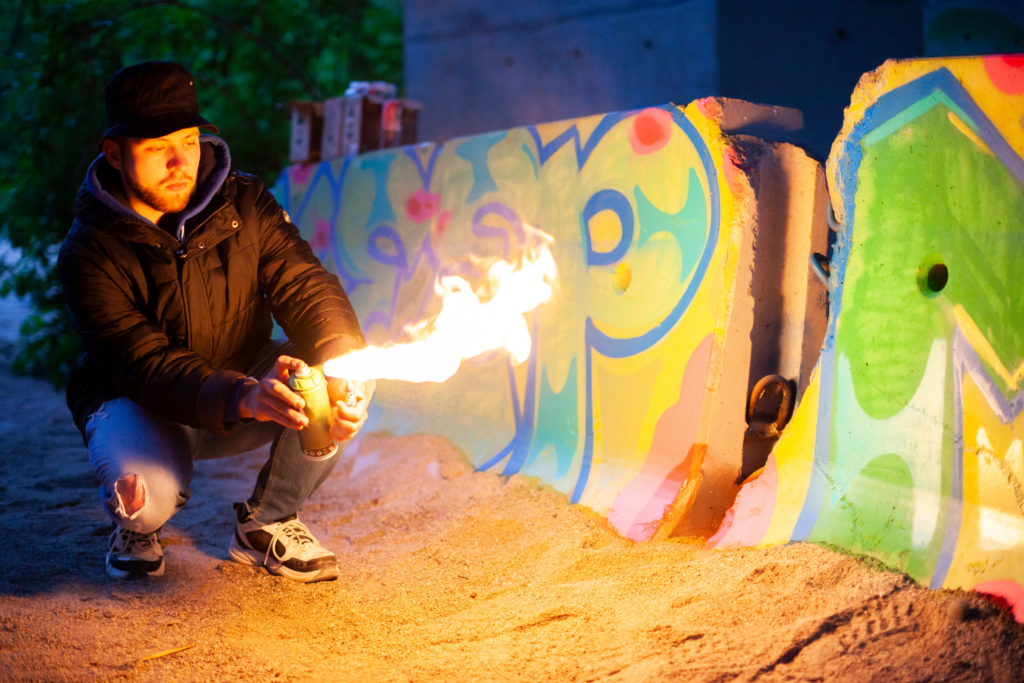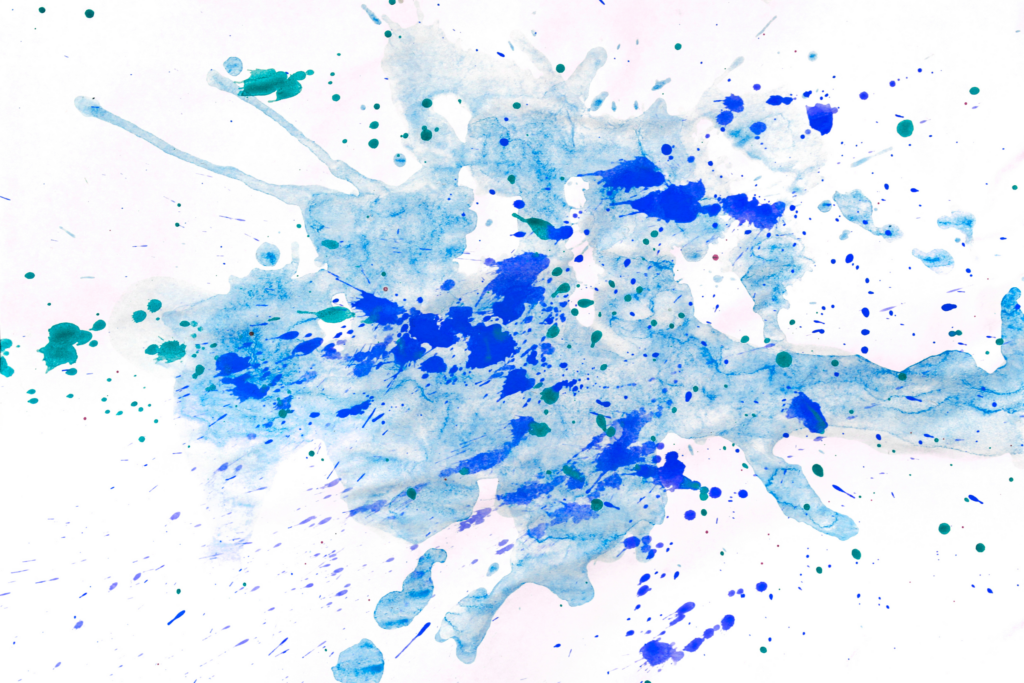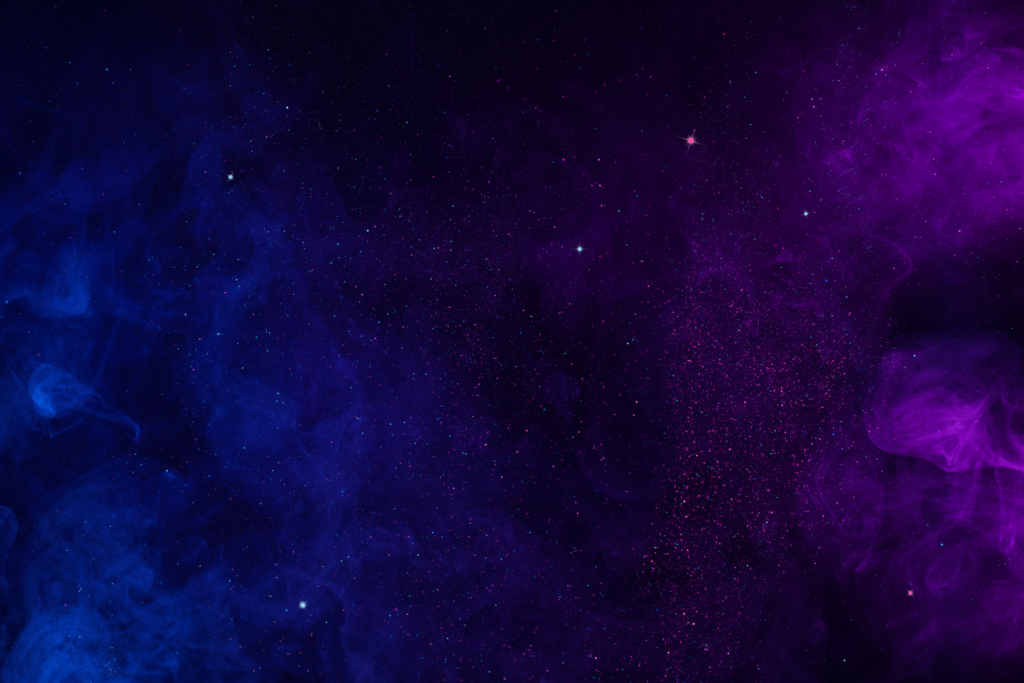Why Do Spray Paint Artists Use Fire? [3 Techniques and Effects]
Did you know that spray paint artists sometimes use fire to create awesome art? Fire is a huge part of the process, but why do they use it?
Spray paint artists use fire as a useful tool to create interesting texture effects or to quickly dry layers of paint while they work. When properly wielded, fire adds another layer of depth to the artwork and contributes to a more engaging and sophisticated look for the final piece.
Despite the inherent risks associated with fire, many spray paint artists have mastered the controlled use of this element, unlocking new possibilities and techniques that push the boundaries of their medium.
In the following sections, we will delve deeper into the reasons why artists employ this unconventional approach and how it has transformed the landscape of spray paint art.
Why do spray paint artists use fire?
So, why do spray paint artists use fire?
Spray paint artists use fire to create their art because it is a useful tool that allows them to get the look they want. The flammability of spray paint makes fire so important since it is the only way to achieve certain results.
By using a flammable medium, artists can manipulate how their work looks by changing the size of the flames. For example, if you are using a smaller flame, it will result in more subtle changes to your work. If you are using a larger flame, it will result in bolder and more drastic changes to the look of your work!
By manipulating the size of the flame, artists can also create unique effects. For example, if they want flames to look more like foggy haze rather than a set of lines, they can use a larger flame. If they want there to be clear outlines around their art, then they will use a smaller flame.
Let’s look at the three biggest effects of using fire with spray paint:
- How fire changes the color of spray paint
- How fire changes the texture of spray paint
- How fire affects spray paint drying time

How fire changes the color of spray paint
The flammability of spray paint also allows artists to achieve different colors with their work. When you use fire, the color is burned into the objects you are working with, and it is why fire can be such an interesting tool.
One of the most common reasons to use fire with spray paint is that the paint may darken or blacken as a result of the heat.
If the paint contains certain pigments that are sensitive to heat, they could change to a completely different color. For instance, red spray paint might turn brown when exposed to fire.

How fire changes the texture of spray paint
One of the primary reasons artists choose to incorporate fire into their spray paint art is the ability to modify the paint’s texture.
Heating the paint temporarily softens it, allowing the artist to create various textures, such as causing it to crack, leading to an aged and contemporary look.
When fire interacts with the paint, it also generates more random effects that may include scorch marks, smoky patterns, or bubbling effects. This variability and randomness help to add a unique touch to the art!

How fire affects spray paint drying time
Contrary to popular belief, using fire in spray paint art is not primarily for quickening the drying process.
In fact, applying fire too closely or for an extended period can even damage or destroy the artwork. Instead, the introduction of fire is mostly to manipulate the paint’s chemical reactions and appearances, leading to distinct outcomes in the final piece.
Depending on the propellant and solvents used in the spray paint, flammability might vary. However, as the fire heats the paint, it often causes the solvents to evaporate more rapidly. This reaction can lead to the top layer of paint drying much faster, although the inner layers might remain wet for a more extended period.
How to use fire on spray paint art?
As with most artistic tools and techniques, there will be a lot of variation when it comes to how and why artists use fire with spray paint. Basically, it will come down to what kind of effect they are trying to achieve.
Generally speaking, a spray paint artist will use a small blow torch for their art which gives them the ability to control both the flame size and heat level of the fire. Blow torches are also designed with safety features in mind so that they can be used indoors without much issue.
For an example of how to use fire with spray paint, check out this video below from popular YouTube channel Skech Art with the artist Stefan Acanski.
Also read: What is The Ball in Spray Paint Can?
How a street artist transforms spray paint art with fire
Spray paint artists use fire in their artwork for a variety of reasons, including enhancing visual effects, creating unique textures, and establishing intriguing patterns.
In this section, we will explore two popular techniques that take advantage of the interplay of fire and spray paint.
Creating space art scenes
Fire is an essential tool in creating space art scenes as it helps to achieve a sense of depth and realism. By using fire, artists are able to control the drying time of the paint layers, allowing for faster work and more advanced layering techniques.
For creating stunning cosmic scenes, artists often use a combination of paint application techniques and the manipulation of fire.
For instance, they may use bright colors for planets and stars, then apply a layer of black paint which is promptly set on fire. The heat from the flames evaporates solvents in the paint, causing the surface to wrinkle and create a textured effect resembling the surface of a planet.
As fire can also create smoke patterns, these patterns bring a sense of movement and depth to the galaxy background of space art scenes.

Abstract painting effects
Fire can be used to achieve extraordinary results in abstract spray paint art. The technique of fumage, originally developed by Surrealists in the 1930s, is a prime example of how artists can incorporate fire into their practice.
In fumage, artists apply light layers of spray paint to a surface and quickly set fire to the paint, resulting in a variety of fluid patterns and organic shapes. The rapid ignition and burning of the paint create distinctive textures that evoke natural elements, such as wood grain or weathered rock.
Notable spray paint artist Matt Sorensen is known for his experimentation with fire in abstract art, using flames to create scorch marks and smoky patterns to infuse his artwork with movement and energy.
When spray paint is ignited, the molten paint briefly adheres to the surface, granting artists greater control over the end result.
Additionally, fire can manipulate the size of the flame, thereby altering the visual impact of the artwork, offering significant flexibility and the opportunity to create visually striking effects.

Innovative spray paint artists
Spray paint artists have long been recognized for their innovative and experimental techniques in creating stunning works of art. One of the most striking methods they use is incorporating fire into their artwork.
This section will discuss some pioneering artists in the field and influential contemporary artists who have used this technique to create exceptional pieces.
Pioneers in the Field
One of the earliest artists to experiment with fire and spray paint is Matt Sorensen, whose work has pushed the boundaries of conventional spray paint techniques. He discovered that applying fire to spray paint can create scorch marks and smoky patterns, lending a unique depth to his artwork.
Another pioneer in using fire in spray paint art is Joseph Finkleman, a professional photographer who also explored the effects of heat on spray paint. His work has demonstrated the importance of proper storage and safety precautions when working with flammable materials like spray paint cans.
Influential contemporary spray paint artists
Today, there are many contemporary artists taking inspiration from the early pioneers and further developing the technique of incorporating fire into their spray paint art.
Some of these influential artists include:
- Paco Rosic: Known for his large-scale murals and innovative techniques, Paco Rosic often incorporates fire in his work to create vivid and striking images.
- Brandon McConnell: A popular street artist who utilizes fire to achieve remarkable textures and finishes in his spray paint art.
- Stefan Acanski: A YouTube artist who gained popularity for his mesmerizing spray paint creations, often enhanced by the use of fire.
These artists demonstrate the versatility and potential of using fire in spray paint art. The science behind this technique revolves around the flammability of spray paint, which allows artists to manipulate their work by controlling the size and intensity of the flames.
The advantages of using fire in spray paint art include creating unique textures, adding a sense of depth, and setting the paint to prevent running or smearing.
As the world of spray paint art continues to evolve, innovative artists will undoubtedly find new and exciting ways to push the boundaries of their medium. With a combination of creativity, experimentation, and skill, these artists demonstrate the incredible potential that exists at the intersection of fire and spray paint.
Spray paint and fire safety
When using fire in spray paint art, it is crucial to prioritize safety. It’s essential to understand the science behind the technique and the precautions artists should take.
In this section, we will discuss safety measures and environmental concerns.
Precautions for artists
When using fire in spray paint art, artists should take specific precautions to ensure their safety and protect their surroundings.
Most people realize that spray paint is pretty flammable, for instance, but can you light a canvas on fire too?
These include:
- Working in a well-ventilated area to avoid inhaling vapors.
- Wearing protective gear such as gloves, masks, and goggles to prevent contact with the skin, eyes, and respiratory system.
- Keeping a fire extinguisher nearby in case of accidents.
- Using fire-retardant materials as a surface for artworks.
- Being mindful of surrounding flammable objects and maintaining a safe distance.
By taking the proper precautions, spray paint artists can create unique works while prioritizing safety.
Environmental concerns
Using fire with spray paint can also raise environmental concerns. Spray paint can release volatile organic compounds (VOCs), which can harm the ozone layer and contribute to air pollution. The addition of fire may exacerbate these concerns due to the potential release of harmful chemicals during the burning process.
Artists should consider using low-VOC and environmentally friendly spray paints to minimize their impact on the environment. Proper ventilation and disposal of waste materials can also help address environmental concerns.
Summary of using fire with spray paint art
In conclusion, spray paint artists often use fire as a tool to enhance their artwork. The science behind using fire in conjunction with spray paint involves the flammability of the paint, as well as the heat the fire generates. The fire can manipulate the paint to create unique textures and patterns and helps the paint adhere better to the surface.
There are several advantages to using fire with spray paint art. Artists can achieve an aged or contemporary look by making the paint crack and creating interesting textures. Moreover, the use of fire challenges artists to push their creativity and expand their boundaries in the world of art.
Notable spray paint artists who have utilized fire in their work include Paco Rosic, who meticulously applies layers of paint with fire to create stunning masterpieces, and Belton Molotow, whose daring approach showcases the vibrant possibilities of spray paint art. These artists have revolutionized the use of fire in their work, inspiring many others to explore this technique.
FAQs related to using fire with spray paint art
What types of spray paint are flammable?
Most spray paints are flammable to some degree, as they contain solvents that can ignite if exposed to heat or flame.
Spray paints that contain highly flammable solvents such as acetone, toluene, or xylene are particularly dangerous and should be used with caution.
Is it safe to use fire on spray paint?
It is safe to use fire on spray paint in a controlled environment and with proper technique.
When using fire with spray paint, special care should be taken to avoid exposing the spray paint cans to excess heat and to avoid inhaling the fumes from the spray paint.
Is spray paint flammable when dry?
While spray paint may become less flammable once it has dried, it can still be flammable under certain conditions.
If the paint is exposed to heat or flame, it can still ignite and burn.
Let Us Know How We’re Doing!
Did this expertly prepared resource answer your question?
Do you have another question about home maintenance, home improvement projects, home appliance repair, or something else?
Get more information, send in questions and keep the discussion going by contacting the I’ll Just Fix It Myself company customer service team at at 1-800-928-1490 or Email us at [email protected]
